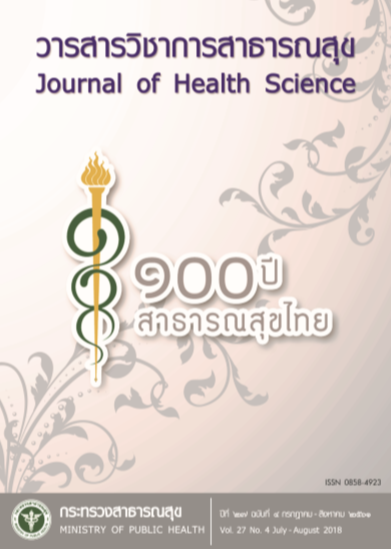Development of Clinical Nursing Practice Guideline among Adult and Elderly Patients with Severe Sepsis in Emergency Department at Rasisalai Hospital, Sisaket Province
Keywords:
sepsis, nursing practice guidelineAbstract
Sepsis is critically a global problem. It leads to the destruction of important organs in bodies and increases the feasibility of disabilities and deaths. Applying an appropriate nursing practice guideline and quick evaluation of medical treatments would help decrease the death rates. This study was a quasi - experimental research, employing one group pretest and posttest design. It aims to explore the results of a nursing practice guideline on treatment and care for adult patients and elderly patients with severe sepsis at emergency department. Evidence-based practice process was utilized as a conceptual framework to develop the nursing practice guideline. The evidence-based practice process consists of 4 stages: (1) finding the clinical problems, (2) finding the clinical evidence, (3) trying out the nursing practice guideline, and (4) applying the revised nursing practice guideline in organizations. Data were collected from (1) health care providers who were 12 registered nurses and emergency room officers, and (2) 44 adult patients and elderly patients with severe sepsis were admitted in emergency department at Rasisalai hospital from august 2014 to march 2015. The comparison of results between pre and post application of the nursing practice guideline was performed by paired t-test, setting the statistical significance at p<0.05. The findings in this study revealed that the nursing practice guideline was able to evaluate the risks of sepsis with the use of SIRs criteria scoring and reported doctors rapidly within 5 minutes at 54.5%. The patients' specimens were sent for culture to detect sepsis in the blood within 45 minutes before the initiation of antibiotic treatment with statistical significance (p<0.001) from 22.7% to 100.0%. In addition, sufficient intrevenous fluid was provided to increase blood pressure to higher than 65 millimeters of mercury. Antibiotic treatment was subsequently administered within 1 hour which was significantly higher percentage than before using the nursing practice guideline (p<0.001) within an average time of 33.86 minutes (SD=8.85, Min=15 minutes, Max=50 minutes). The satisfaction and opinions towards the appropriateness of the nursing practice guideline were at very high level (91.66%), (95%CI=61.52-99.78). Thus, this nursing practice guideline was able to quickly assess the risks of sepsis, increase the quality of antibiotic treatment within 1 hour, and solve the critical issues appropriately.
Downloads
Downloads
Published
How to Cite
Issue
Section
License
Copyright (c) 2018 Journal of Health Science- วารสารวิชาการสาธารณสุข

This work is licensed under a Creative Commons Attribution-NonCommercial-NoDerivatives 4.0 International License.







